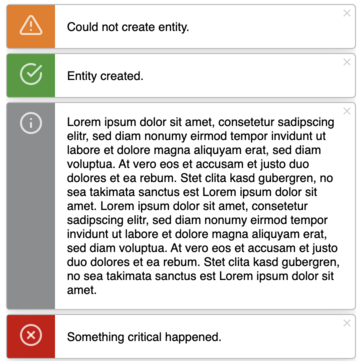Install: elm install mercurymedia/elm-message-toast
Display a list of small popups with a feedback message to the user (default 4 at a time). The popup disappears automatically after a few seconds (default 8 seconds) or if the user taps on it.
There are 4 different types for the message to choose from: Danger, Info, Success and Warning
The package offers a way to use the MessageToast fully pre-configured, which makes it easy to use. There's also ways to customize the MessageToast to some individual needs (e.g. number of messages shown at the same time, delay until a message disappears or customized attributes).
Usually there will be only one MessageToast declaration on the model, since the message popups will be in one group and share the same settings. Multiple attributes are only necessary if separate configurations are used.
The pre-configured MessageToast is initialized with init.
import MessageToast exposing (MessageToast)
type alias Model =
{ messageToast : MessageToast Msg }
initialModel : Model
initialModel =
{ -- MessageToast requires by default only the message to update itself to the model
messageToast = MessageToast.init UpdatedSimpleMessageToast
}To provide custom settings use initWithConfig.
{ -- MessageToast can also be initialized with custom settings
messageToast = MessageToast.initWithConfig UpdatedCustomMessageToast { delayInMs = 2000, toastsToShow = 10 }
}The MessageToast can update itself, so that it's only required that the updated MessageToast will be set on the model.
UpdatedSimpleMessageToast updatedMessageToast ->
-- Only needed to re-assign the updated MessageToast to the model.
( { model | messageToast = updatedMessageToast }, Cmd.none )The default view of the MessageToast can be shown by simply passing the MessageToast into the view function.
view : Model -> Html Msg
view model =
div [ style "width" "100vw", style "height" "100vh" ]
[ -- Only need to pass the proper MessageToast
MessageToast.view model.messageToast
...
]However, the MessageToast can be customized in a certain extent by overriding attributes (and therefore also stylings) using provided functions (overwriteContainerAttributes, overwriteToastAttributes, overwriteMessageAttributes, overwriteIconAttributes). For further informations see docs.
view : Model -> Html Msg
view model =
div [ style "width" "100vw", style "height" "100vh" ]
[ -- Stylings (or in general Html.Attribute's) of the MessageToast view can be overridden
model.messageToast
|> MessageToast.overwriteContainerAttributes [ style "top" "20px", style "bottom" "auto" ]
|> MessageToast.overwriteToastAttributes [ style "font-size" "1rem" ]
|> MessageToast.view
...
]So that the MessageToast can automatically pop off the time-wise oldest message, simply connect the subscription of the MessageToast to the application.
subscriptions : Model -> Sub Msg
subscriptions model =
-- MessageToast provides a subscription to close automatically which is easy to use.
MessageToast.subscriptions model.messageToastHowever, if this functionality of automatically disappearing messages is not wanted, this part can be skipped.
To show a message popup simply generate a toast with one of the 4 type functions (danger, info, success, warning) and call a function onto it to display it with your individual needs.
The simplest way is done by piping the generated toast into MessageToast.withMessage.
Example:
-- Message that assigns a new "Danger" message toast to the MessageToast handler with default HTML layout.
ShowDanger ->
let
messageToast =
model.messageToast
|> MessageToast.warning
|> MessageToast.withMessage "My warning message"
in
( { model | messageToast = messageToast }, Cmd.none)This will display the message with the default HTML layout of the MessageToast.
If you want to customize the layout, you can instead pipe the generated toast into MessageToast.withHtml and provide a individual structured HTML layout for the content of the MessageToast.
Example:
-- Message that assigns a new "Danger" message toast to the MessageToast handler with user defined HTML layout.
ShowDanger ->
let
messageToast =
model.messageToast
|> MessageToast.warning
|> MessageToast.withHtml (div [] [ text "My title", text "My warning message body" ])
in
( { model | messageToast = messageToast }, Cmd.none)Examples can be found in the examples/ folder. To build the examples and view it in the browser you can simply run elm make examples/Default.elm or elm make examples/Configured.elm.

